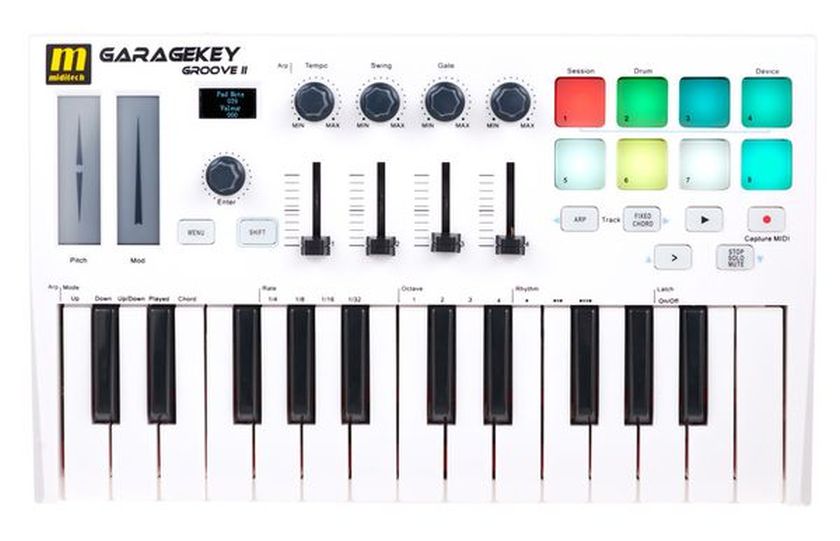Knowledge Center
MIDI device

In this example we are using a Garagekey Groove II MIDI keyboard and make music/playback it on an Orange Pi ZERO3 trough LINE-OUT
dmesg
[ 1609.117012] usb 4-1: new full-speed USB device number 3 using ohci-platform
[ 1609.344060] usb 4-1: New USB device found, idVendor=1c75, idProduct=0204, bcdDevice= 1.00
[ 1609.344090] usb 4-1: New USB device strings: Mfr=1, Product=2, SerialNumber=0
[ 1609.344110] usb 4-1: Product: MIDITECH
[ 1609.344127] usb 4-1: Manufacturer: **aseqdump
sudo aseqdump -l
Port Client name Port name
0:0 System Timer
0:1 System Announce
28:0 MIDITECH MIDITECH MIDI 1You can see the port number: 28
Test MIDI input (note view) #
aseqdump
sudo aseqdump -p 28
Waiting for data. Press Ctrl+C to end.
Source Event Ch Data
28:0 Note on 0, note 64, velocity 69
28:0 Note off 0, note 64, velocity 0
28:0 Note on 0, note 55, velocity 13
28:0 Note off 0, note 55, velocity 0
28:0 Note on 0, note 52, velocity 13
28:0 Note off 0, note 52, velocity 0
28:0 Note on 0, note 56, velocity 65
28:0 Note off 0, note 56, velocity 0
28:0 Control change 0, controller 77, value 46
28:0 Control change 0, controller 77, value 45
28:0 Control change 0, controller 77, value 44
28:0 Control change 0, controller 77, value 42
28:0 Control change 0, controller 77, value 41
28:0 Control change 0, controller 77, value 39
28:0 Control change 0, controller 77, value 38
28:0 Control change 0, controller 77, value 37
28:0 Control change 0, controller 77, value 35
28:0 Control change 0, controller 77, value 34
28:0 Control change 0, controller 77, value 33
28:0 Control change 0, controller 77, value 32
28:0 Control change 0, controller 77, value 31
28:0 Control change 0, controller 1, value 4
28:0 Control change 0, controller 1, value 11
28:0 Control change 0, controller 1, value 23
28:0 Control change 0, controller 1, value 39
28:0 Control change 0, controller 1, value 47
28:0 Control change 0, controller 1, value 55
28:0 Pitch bend 0, value 3806
28:0 Pitch bend 0, value 5999
28:0 Pitch bend 0, value 5741
28:0 Pitch bend 0, value 5612
28:0 Pitch bend 0, value 5632
28:0 Pitch bend 0, value 5020
28:0 Pitch bend 0, value 4408
28:0 Pitch bend 0, value 3796
28:0 Pitch bend 0, value 3184
28:0 Pitch bend 0, value 2444
28:0 Pitch bend 0, value 1832
28:0 Pitch bend 0, value 1220
28:0 Pitch bend 0, value 608
28:0 Pitch bend 0, value 0
Test MIDI input (RAW) #
amidi
sudo amidi -l
Dir Device Name
IO hw:3,0,0 MIDITECH MIDI 1Here you can see the hw number 3,0,0 assigned
NOTE: you can also see the hw number if you list the /dev/snd folder:
ls /dev/snd
by-id controlC0 controlC2 midiC3D0 pcmC2D0c seq
by-path controlC1 controlC3 pcmC0D0p pcmC2D0p timerHere you can see midiC3D0, wich resembles hw 3,0
dump midi values
sudo amidi --port="hw:3,0,0" --dump
90390B
903B0D
903C36
903E39
803900
803B00
803C00
803E00
B04D31
B04B2D
B04B2E
B04B2F
B04B31
B04B32
B04B33
B04B35
B04B36
B04B37
B04B38
B04B39
B04B3A
B04B3B
B04B3C
B05D41
B05D40
Install MIDI synthesizer #
Fluidsynth
sudo apt install -y alsa-utils fluidsynth fluid-soundfont-gmTest NOTE
test notes on fluidsynth
sudo fluidsynth -a alsa -m alsa_seq /usr/share/sounds/sf2/FluidR3_GM.sf2in the console of fluidsynth type
noteon 1 60 100You should here a note play
Test MIDI file
Download a midi file
wget https://files.khinsider.com/midifiles/snes/super-mario-world/overworld.mid -O test.midCheck if the file is a midi file:
file test.mid
test.mid: Standard MIDI data (format 1) using 19 tracks at 1/120Play the midi file
sudo fluidsynth -a alsa -m alsa_seq -i /usr/share/sounds/sf2/default-GM.sf2 test.midor
sudo fluidsynth -a alsa -m alsa_seq -i /usr/share/sounds/sf2/FluidR3_GM.sf2 test.midConnect and route the midi keyboard #
So if you look at the “audio” devices with:
sudo aconnect -lYou will see something like:
client 0: 'System' [type=kernel]
0 'Timer '
1 'Announce '
client 28: 'MIDITECH' [type=kernel,card=3]
0 'MIDITECH MIDI 1 'Where device 28 is the midi keyboard
Now to open fluidsynth and to prevent multiple SSH sessions, because fluidsynth need to be running, we can run fluidsynth in the background with this command:
nohup sudo fluidsynth -a alsa -m alsa_seq --server /usr/share/sounds/sf2/FluidR3_GM.sf2 > fluidsynth.log 2>&1 &And if you list the devices with aconnect you will now see:
sudo aconnect -l
client 0: 'System' [type=kernel]
0 'Timer '
1 'Announce '
client 28: 'MIDITECH' [type=kernel,card=3]
0 'MIDITECH MIDI 1 '
client 128: 'FLUID Synth (2506)' [type=user,pid=2506]
0 'Synth input port (2506:0)'Where device 128 is fluidsynth.
Now we have to redirect the input from the keyboard (device 28) to the synthesizer (device 128), with this command:
sudo aconnect 28:0 128:0Now the devices are connected, you can check it again:
sudo aconnect -l
client 0: 'System' [type=kernel]
0 'Timer '
1 'Announce '
client 28: 'MIDITECH' [type=kernel,card=3]
0 'MIDITECH MIDI 1 '
Connecting To: 128:0
client 128: 'FLUID Synth (2506)' [type=user,pid=2506]
0 'Synth input port (2506:0)'
Connected From: 28:0You can see the “connecting to” and “connected from”
If you now press keys on your keyboard you will hear the sound!, enjoy!


